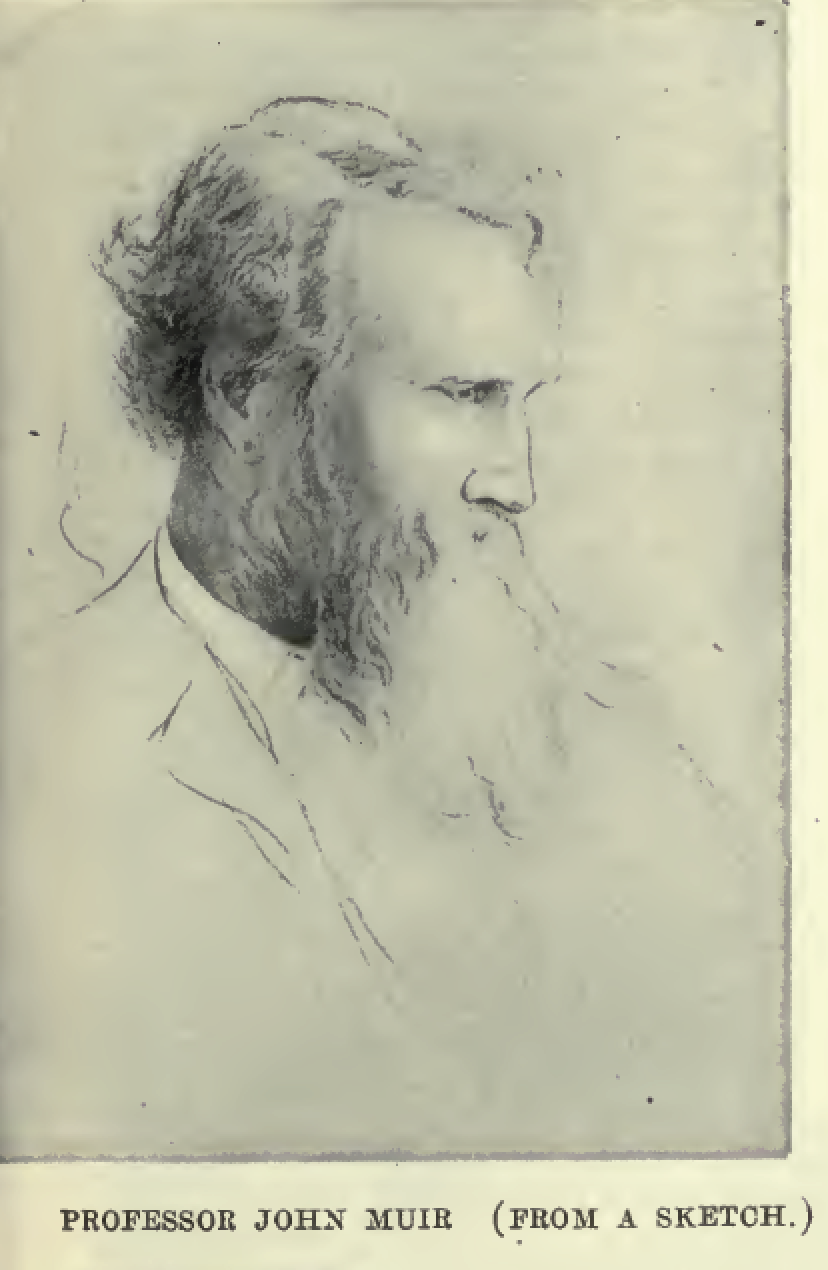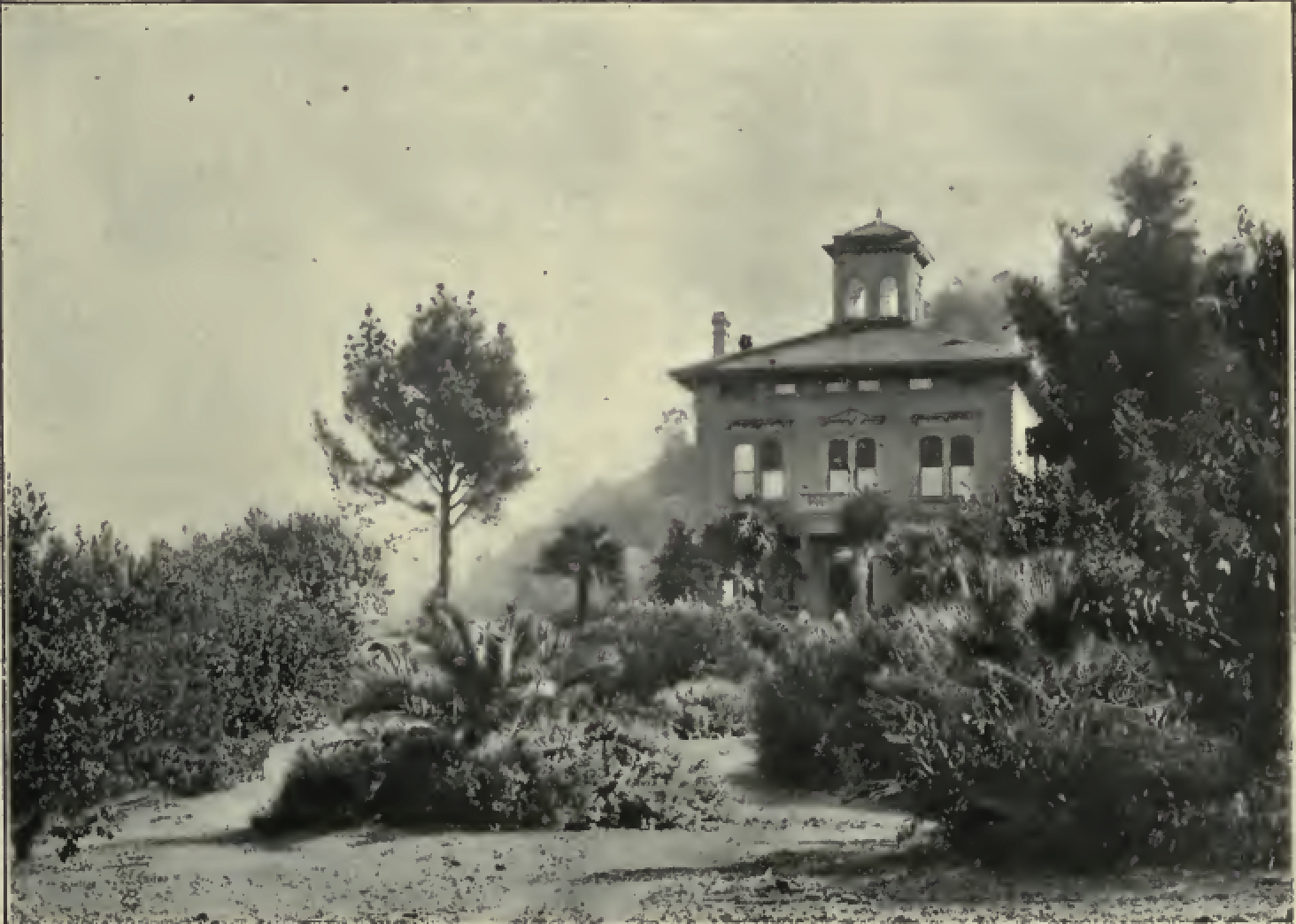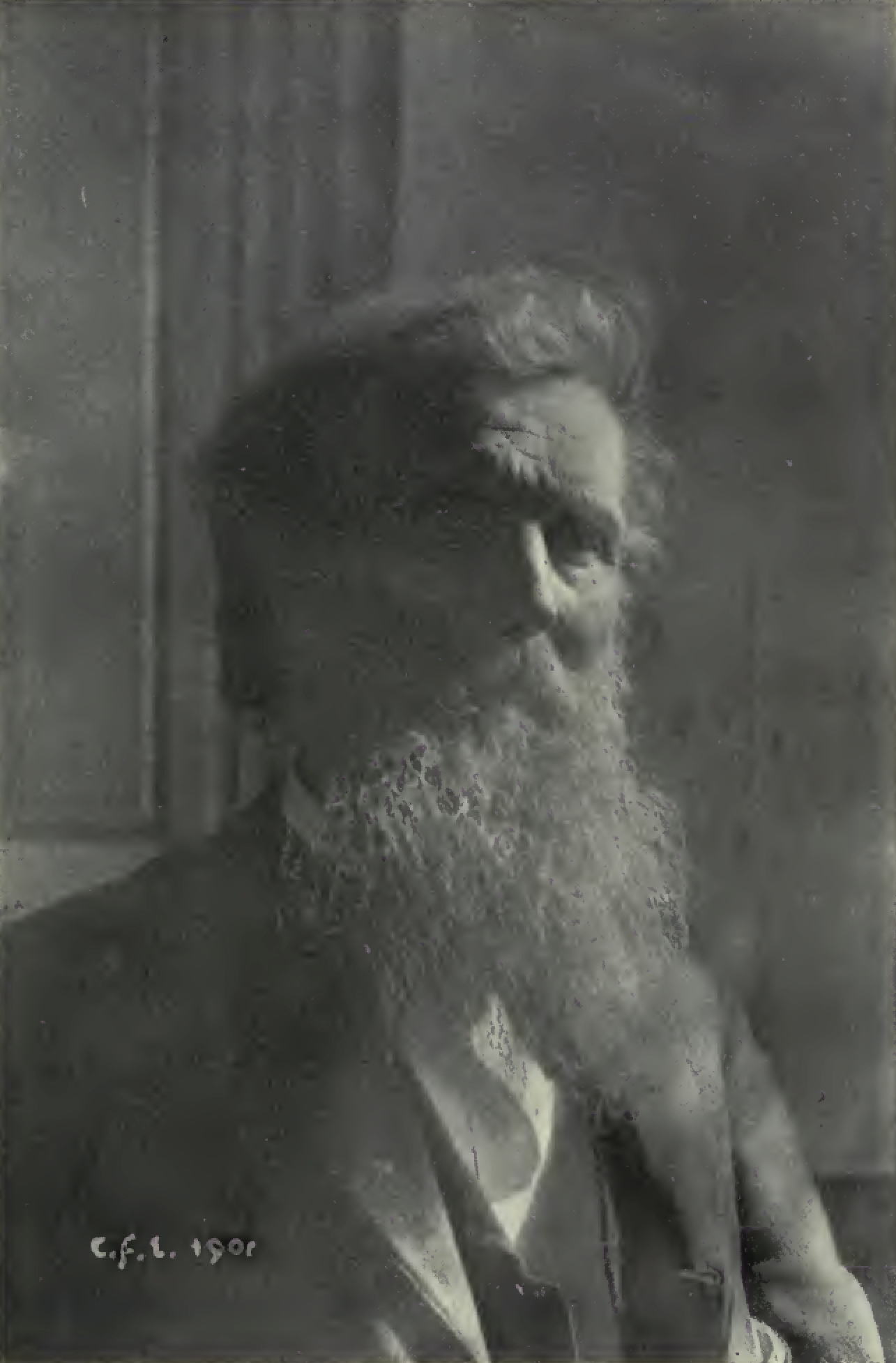the john muir exhibit - life - at home with john muir
At Home with John Muir
by George Gerard Clarken
From: Overland Monthly, Vol 52, No. 2, August, 1908, pages 125-128
Download a PDF of this article from original Overland Monthly magazine.
John Muir belongs to California and California to John Muir. Muir is an inalienable asset, just as much as the poppy and the redwood, the climate and the flowers. Mr. George Gerard darken has given us a keen appreciation of Mr. Muir and his characteristics, a valuable addition to the chronology of famous Californians published in Overland Monthly from time to time. It is the editorial policy of this magazine to laud a man while he is alive rather than sing his praises after his death.
EDITOR OVERLAND MONTHLY. |

We of California, with our birthright of sunshine and flowers, are wont to accept the distinction with that complacency generally exhibited by any one whose earliest remembrance follows him unchanged through life, and are likely to pay scant heed to those benefactors of natural science who have brought us to a clearer understanding of our environment.
While unmistakably proud of the national reputation of California as a State of flowery profusion, we might go a step farther and glance into the lives of the men who have brought us in touch with nature and given to the world the result of their labors.
Perhaps the greatest natural scientist in the United States to-day, and to whom every cultured people of the globe are indebted, is John Muir, the Burroughs of California, who has come out of the deserts and mountains with geological and botanical treasures, and laid them at our feet that we might profit by his investigations.
John Muir's name has been spoken in every corner of the globe; indeed, during his travels he has minutely studied from the frozen wilds of far Alaska to the tropics of South America and Africa. And while he has been studied much in the same manner in which he studies, he has seldom been met in the quiet of his library or his garden, or while applying himself to those pleasure-duties which occupy him throughout the day, and at times far into the night.
Muir has been likened to Joaquin Miller, and the similarity in temperament and aim is closely akin. He possesses the same keen, dominant desire for shearing nature
of the prosaic and treating it as the most beautiful handiwork of creation, as does
the Poet of the Sierras. He would sleep in the fields that he might learn the flowers, or in the forests to be close with the trees as they tower above him. Beside a rivulet or on barren plain, in valley or in the deep solitude of mountain peak, John Muir is content. All are his companions, his earth-born studies holding out new possibilities with each visit, and appealing to him with a silent sympathy such as only years of close association can make possible.
While his literary efforts have seldom resolved themselves into verse, he writes with a wonderful mastery at his command, born of long years of study, concentration and affiliation with his subjects. Muir has spent years in the depths of the Yosemite forests, and years more in the desolate wastes of Arizona's deserts, communing with nature in her swaddling clothes, and studying, analyzing and noting. He declares the happiest days of his life have been spent on mountain side, in the sun-baked deserts or beneath the shade of a redwood grove. A blanket and a little food in the wilderness transform it into a paradise to John Muir, for he long ago allied himself with primal conditions, and made them his life study. What he begins at such times as he is away from
home, he completes in the quiet of his
spacious residence, surrounded by massive
and comprehensive volumes on geology
and the sundry phases of plant life.
Queer as it may seem, this venerable
man no longer regards his hearthstone
as a home, but purely as a place where he
may have those conveniences, which
are
not at his command in a tent on mountain
or plain. Save for the additional facilities
to be obtained for study, he and the four
walls of a house would be aliens, and, as
he apologetically remarked some time ago
to a man who said he was glad to see him
home again: "Why, this isn't my home.
It is on the mountains or in Arizona. I'm
simply here to secure that rest which my
body demands. I am getting old, you
know, and what was mere exercise a few
years ago is fatiguing exertion now." This
is the artist speaking in Muir, and when
it is known that he prefers a soughing west
wind to the melody of other music for his
De Profundis, it is not difficult to abide with him
In his selection of a home, Muir sought
to combine massiveness with simplicity, and at the same time preserve harmony
in the contrast. He chose the site for his
house in one of the most beautiful locations
in the Contra Costa Valley, where inspiration sighed with the winds and where he could perchance dream himself back to the Yosemite and fear no disappointßent
upon awakening.
Sheltered on one side by a wooded hill
and surrounded on three others by vineyard,
orchard and stream, overlooking
miles of rolling landscape, and in the
very shadow of towering Mt. Diablo, this
mansion commands a magnificent scope
of view. In the garden he planted countless
varieties of tree and shrub, and let
nature run riot in luxuriance. Pine and
palm and cacti bow to each other in the
breezes while the thousand scents of budding
fruit trees waft themselves incenselike
through his study window. A winding
walk of concrete leads around the
place through profusions of bloom and
fruit, and four stately tropical palms
stand sentinel like before his door.
Within, one is introduced to simple
elegance. The hardwood floors are hidden by rich Oriental rugs, and the reception room, with its immense fireplace and paintings of the Yosemite, proclaim the aged master of the place an artist by temperament and taste. No glaring monstrosities of the wood turner's art are to be seen in any corner, for he carefully planned the furnishings, and brought with him nothing that could not serve some end other than display. Two Morris chairs, a rocker, table or two, several pictures and bits of petrified wood on the long, narrow mantel-piece about the chimney, comprise the furnishings and combine the antique with the modern. But there are evidences of a more feminine hand in the appointment of the room than John Muir would perhaps care to have called his. Off in a corner is a settle almost hidden by handworked fancy pillows, one with the letters "U. C." worked in 'blue and gold, another with a painting of a California poppy, and still one more with a Gibson creation worked through the facing in silk and water color.
Let it be known here that John Muir does not live alone, nor study without a companion. The feminine touches were the work of Miss Helen Muir, daughter of the house, and a true product of the West. While we drew mental pictures of her, expecting the appearance of a young woman in fluffy creations of a stylish dress-maker, the Troy maiden entered frank, healthy-cheeked and with a firm tread, which bespoke an outdoor life. A blue army shirt, string tie, old skirt and heavy boots, gauntleted, and wearing the regulation cowboy hat, she stood before us with a grace 'of manner which would have put to shame her sisters of silks and satins.
Would Mr. Muir be interviewed? No, she hardly believed he would. But we might try. "There's nothing like making the attempt," she hastily temporized, with a laugh, and vanished to her father's study. While awaiting her return, we had ample time to study the scenes which unfolded themselves on three sides through the windows of the room. To the south lay the Santa Fe viaduct, the longest in California, piercing the hills on one end and losing itself in a tunnel on the other. Muir station, named after the aged naturalist some years before, stood oft' to the east, while the valley below, blinking in the early afternoon sunlight, wandered vagrantly to north and south.
I will not soon forget my first impression of John Muir. Many times had I seen his photographs, but until now had never grasped his hand, a hand, by the way, as creased as his broad face, and still retaining a strength at 70 that many of half his age might envy. He was seated as we entered, and closely bent with microscope to his eye studying the formation of a bit of petrified wood. His greeting was hearty, his grip firm, and his words echoing a strange note. It was as though he had partaken of the strength of his subjects, as though the blood in his veins ran iron, and his eyes were of steel. There was a vigor and manhood about John Muir that stamped him as strong of mind as of limb, and possessing the full courage of his convictions.
 His face must appeal to any student of human nature seeking facial expression, of an underlying great mind and learning. The brow, while lined with deep furrows is lofty, and his hair, almost iron-gray, sweeps well back from the forehead, while the eye-brows have adopted that quizzical contraction following constant study and deep thought. The eyes themselves are well apart and clear, the cheek-bones setting well up above his beard and lending
them additional intellectual tone. Could
one penetrate the bushy beard which
sweeps down upon his breast, the same
effective strength which characterizes the
rest of his face and personality would
show its lines about his mouth. But John
Muir never shaves, and nature, curbed to
a rough nicety, has not felt the blade of
razor. And to see him and study the contour
of his face would mean to agree that
the cultured and kindly eyes, the fearless
poise of his head and the wrinkles born of long application, would not well permit
of the sacrifice of his beard. It is to
him that "something" which is the distinctive
feature of all great men. Without
it, his appearance would be so altered
as to be almost unrecognizable. He is
strong in mind, body and personality. To
meet him is to be won by his quiet commandery,
and to know him is to be infused
with his strength.
His face must appeal to any student of human nature seeking facial expression, of an underlying great mind and learning. The brow, while lined with deep furrows is lofty, and his hair, almost iron-gray, sweeps well back from the forehead, while the eye-brows have adopted that quizzical contraction following constant study and deep thought. The eyes themselves are well apart and clear, the cheek-bones setting well up above his beard and lending
them additional intellectual tone. Could
one penetrate the bushy beard which
sweeps down upon his breast, the same
effective strength which characterizes the
rest of his face and personality would
show its lines about his mouth. But John
Muir never shaves, and nature, curbed to
a rough nicety, has not felt the blade of
razor. And to see him and study the contour
of his face would mean to agree that
the cultured and kindly eyes, the fearless
poise of his head and the wrinkles born of long application, would not well permit
of the sacrifice of his beard. It is to
him that "something" which is the distinctive
feature of all great men. Without
it, his appearance would be so altered
as to be almost unrecognizable. He is
strong in mind, body and personality. To
meet him is to be won by his quiet commandery,
and to know him is to be infused
with his strength.
John Muir is distinctly of the great West, and not alone that, he is of California,
with the rugged vigor of the
mountain air in bis lungs and the firea of
Southern deserts in his eyes. Give him
the open country or the wooded hill, the
grandeur of the Yellowstone or the barren
wastes of an alkali plain, and in one, as
in the other, he sees only that which is
beautiful, although to any but a lover of
God's own nature there could be no pleasing
significance.
His study represents the work of a lifetime
in contents. Unlike the dens of
many scientists and naturalists, this room
is scrupulously clean, and even the shelves
and cases of minerals, relics of the Indian
age and phenomena of land and sea, are
carefully dusted. In themselves, all of
these things may be considered trivial, but
they reflect John Muir in many ways, and
are typical of the nature of this great and
good man.
In the early morning he is about in
the grounds watching the growth of his
garden and pruning, transplanting or
studying the trees and shrubs. An hour
or more he spends thus, learning the leaves
and flowers, and calling the birds from the
orchard below to flock about his feet. As
an exponent of the simple life, John Muir
is a distinct type. His strength is even
stronger because of its simplicity, and yet
to watch him at his work, few would deem
his duties a pastime. During the remainder
of the day, he may be found in
his den either with microscope as we
came upon him or adding closely written
lines to a voluminous manuscript,
which, dealing with the result of his research,
is shortly to appear in book form.
He works leisurely but steadily, and if he
is fatigued at evening, his face fails to
show it.
It is wonderfully quiet about John
Muir's unique home. There is nothing to
disturb his solitude save the occasional
rumble of a train across the viaduct, and
this, soon losing itself in an echo among
the hills, is the connecting link of the
Primitive and Modern in his life.
At night he scorns the bondage of his
room for a couch on the dormer balcony.
With the weird wail of a skulking coyote
or the screech of a distant owl coming to
him as a call from the great wilderness,
he knows and loves so well, the goodnight
twitter of his feathered friends lulls him
to sleep and rest for the few hours between
darkness and dawn.

Posted 15 May 2019.
Home
| Alphabetical Index
| about this Site &What's New